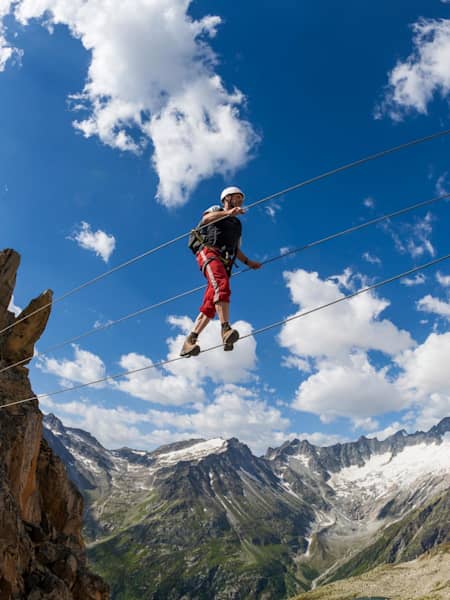Latin for 'iron way', a via ferrata is the bridge between scrambling and climbing. It requires very little equipment and a good head for heights. Unlike climbing or bouldering problems, a via ferrata is a route marked out by metal rails and rungs embedded into the mountain. It's easy to follow and a great way to tackle otherwise impassable cliffs and ledges. Whether you’ve done it before or are planning a new adventure, these are eight things that you need to know about via ferratas.
1. Go early to avoid the queue
Via ferratas have one set route that everyone has to follow. You’re all clipped onto the same wire, which makes it difficult to overtake. On popular routes, the entire wire can become a huge queue, blocked up by people going slowly at the front.
To get the route to yourself, go early. This means getting on the first cable car up the mountain, or before it opens if you can.
2. Wear gloves and take a small rucksack
The bare minimum you need to do a via ferrata is a harness, a via ferrata kit (like these at Rock + Run) and a helmet. Your experience will be more comfortable if you wear padded fingerless gloves and take a small rucksack. Via ferratas are more like extreme scrambling than climbing, so it’s fine to do it in walking boots – no special shoes required.
However, via ferrata gear does have a history of recalls. Be careful to buy good quality kit because, after all, it will be saving your life if you fall. Stay well clear of anything that has a static rope in it. They’re the equivalent of climbing in hobnail boots and have since been replaced by a much safer shock-absorbing system. Although they’re an antiquity, they are still lurking around – avoid!
3. Clip in as far forward as you can
You made it to the start of the route, all safely kitted up with a gap in front of you. All you have to do now is clip the quickdraws onto the wire and you’re away. Climb up beside the wire and slide the karabiners along it as you move.
The wire is bolted into the mountain at regular intervals. When you reach a bolt, unclip the top karabiner and place it onto the next wire. Then undo the second and put it next to it. You should always have one karabiner attached to the wire.
The bolts stop you from sliding all the way back down the wire if you fall off. So, to break your fall early, it’s best to clip in as far forward as you can – even above the next bolt if you can reach. If you slip near the top of a wire, you’ll fall the length of the wire before the via ferrata kit kicks in. This is potentially a huge fall factor, with the chance of bouncing off the rock on the way down.
4. You have to commit
Most via ferratas have only one set route that takes you from start to finish. Although this makes navigation easy, it also leaves you stuck on the route once you’ve started. Some guidebooks will offer escape routes, but many don’t. The only way off is back down and all the people coming the other way won’t be very impressed. Similarly, there aren’t a lot of toilet spots on an exposed rocky edge...
5. Don't always trust the guidebooks
We’ve all been there – you see an epic picture in a guidebook with a route description that sounds exciting. Then you get there and the picture was taken at a very clever angle – that 300m chasm is more like a metre and that endless bridge looks like something from a children’s playground.
Some guidebooks like to make the routes look more extreme than they are. Sales brochures will do the same. Don’t be disappointed. At the very least, you can try to replicate their clever photo angles for your friends.
6. Beware of the elements
Most mountaineers don’t care too much about bad weather. Snow, rain, sun, wind – they’ll kit up and take on the mountain regardless. With via ferratas, you have to be a little bit more careful. Snow and ice are not a problem, although they’ll make your footholds slippery. However, if there’s a storm coming in, you have to be cautious. After all, you’re on an exposed mountain ridge with no escape routes, attached to a long metal wire...
7. It’s not always free
There are hundreds of free via ferrata routes across the world – particularly in the Alps and Dolomites. These are typically on land open to the public. But many are run as commercial enterprises, where the land is privately owned – so check each route in advance.
8. Via ferratas were increasingly used during the First World War
There are two main types of via ferrata. One sort, often found in France, is more like a climbing route. You climb from the bottom to the top of a mountain or crag (pretty vertically) and walk back down again. It’s a problem to solve and a fun day out.
The other type is to use via ferrata to get between mountains – a way of taming an otherwise inaccessible ridge. This is one of the original uses of via ferratas, frequently used during the First World War to move troops across the mountains.








